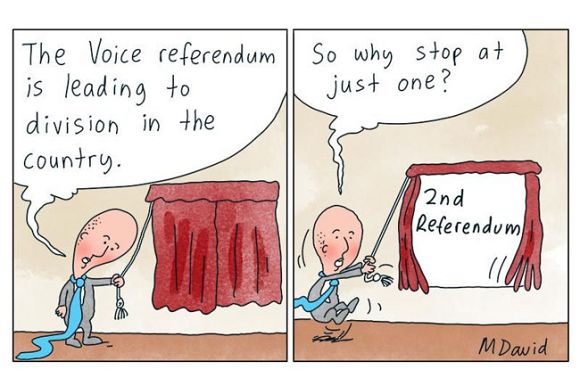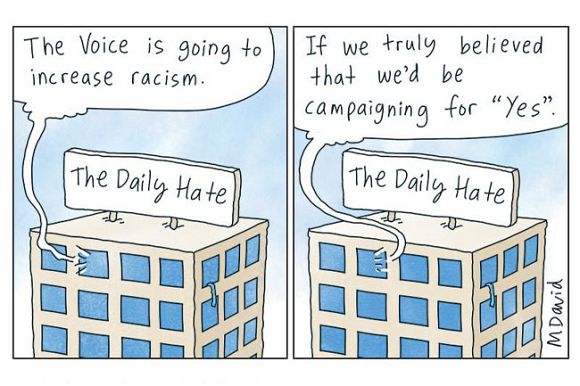The Voice Referendum presents voters with many dilemmas, including, for “Yes” voters after a secret ballot, how to tell who not to invite into their homes, writes Dr Lee Duffield.
THE VOICE REFERENDUM of 2023 was not meant to be about race or politics but was made that way and opened historical old wounds.
It started with a Liberal government supporting a bipartisan agreement on recognition of Indigenous Australia, was developed by the Uluru process and taken up by Labor in government, then taken to a popular vote for endorsement as a change in the Constitution.
Straight deal — no points for discussion
It was an appeal for moral restitution, to recognise Indigenous Australia, the country that was invaded and its surviving population. Those were identified essentially as descendants of the people who held the land, not identified essentially by race. None of that was a matter of points for a political discussion. Either you wanted to do this act of justice or you did not.
The Prime Minister of the country supported it and the Opposition Leader was invited to do the same, along with the premiers, all citing the uncomplicated line of giving a fair go at last to Indigenous citizens. Major organisations and institutions stepped up, and many distinguished individuals, such as Cate Blanchett, Cathy Freeman, John Farnham, Nathan Cleary, plus millions spontaneously going on marches, door-knocking and contributing to the huge poster campaign.
But the decision of the conservative parties to oppose the Voice, after all, made the Referendum political and all over again that stirred up a race issue.
It was done firstly as it offered those parties the chance of a win, since referendums usually fail unless all parties support them.
And also it would give them access to a same-old niche of voters across party lines – maybe 10 per cent overall – with a race-conditioned outlook, who can always be mobilised for a while around chauvinism and colour.
Be dumb if you like
As it happened, apart from a mish-mash of talking points, we actually saw the idea of referendum inertia, where apathy turns into a “change-nothing” “No” vote, blatantly put up as the main argument for “No”.
Facebook and text messages from the Liberal Leader, Peter Dutton and the Nationals’ spokesperson, Jacinta Nampijinpa Price, said if you don’t know about it, say “No”.
Maybe find out? No.
Contrarians
Inevitably, there would be contrarians and black faces in the “No” camp, naturally given a lot of air-play and none given a political belting, as in normal political campaigns, because of the way it was: the “Yes” side was for a proposition that anybody could understand; it was not getting into points for discussion.
In the case of Price, we had the riddle of why a youngish, Black-coloured woman would be associated with rich squatters, some of them compromised from birth because of the way certain forebears got the land; with the radical Right in ideological politics; with out-and-out saluting White supremacist thugs on the margins of society; or with peddlers of disinformation on a scandalous scale — like the story that Australian jurists thought a “Yes” vote would get the country bogged down in impossible court cases.
The person was managed in the campaign by the Sydney-based rightist organisation, Centre for Independent Studies, not that much else being widely known about the preparation of this political figurehead as an individual.
Risky — details
It would be very risky to take that much notice of an unknown.
Maybe it should be a case of demand all the details — otherwise say “No” to this no-sayer.
In a similar case, we had Warren Mundine, a man known to be anxious to get a seat in parliament, acting like “Uncle Tom”, but having to fumble around explaining his past backing of proposals like a treaty. Those went back to his time with the Labor Party, which did not provide him with a seat.
Maybe the Liberals will provide him with one for his attempt to help in this campaign, but maybe not. Maybe he will become a fight promoter; he said his second cousin, the boxer Anthony Mundine, was ready to go a few rounds against the “Yes” crowd.
Seen it all before
We have seen it all before, including very strong campaigns against the racially jaundiced impulses of the 10 per cent. “Yes” in 2023 was going to get strong backing in many parts of society because of the commanding moral issue of justice for Indigenous Australians.
It was similar in the 2001 Election over the stranding of would-be refugees on the ship Tampa, amid false claims that asylum seekers were, in desperation, throwing their children into the sea. It stirred up enmity against immigrants. The cynicism of it paid off for the coalition government of the day, under John Howard, by blotting out issues where it was running behind in the imminent election.
An election fought in 1966 over the commitment of conscripted troops to Vietnam saw the same mobilisation of prejudice, on that occasion against the “yellow peril”; fear of a second invasion of Australia — by Asian communists.
At federation in 1901, the Australian colonial governments got their way: separation from England and amalgamation as states in a new country that banned non-Europeans outright. That ban provided a strong balance of public support for the project, a guarantee delivered by racial prejudice, to overcome sentiment in favour of staying with the mother country.
Reputations — stone the crows!
It is a tremendous pity if a great country, democratic and prosperous, able to take a lead internationally, cannot get over these corrosive hatreds. One great problem of a “No” vote, for “Yes” voters, must be that it was a secret ballot, so that, while so many stood up to give public support, so many others could say nothing and do it under cover. How to know, then, for sure, who not to invite into your home?
Post-referendum, no matter the outcome, “No” voters who claim not to be racist, like many of their allies in that contest, might be reminded of the adage: ‘If you fly with the crows, you get shot with the crows.’ Internationally, with a “No” vote, Australia would have to be mud. All those – and there are many – wanting to put down Australians and harm their interests must be thinking and talking about those crows.
Among his vast journalistic experience, Dr Lee Duffield has served as ABC's European correspondent. He is also an esteemed academic. He is a member of the Editorial Advisory Board of Pacific Journalism Review.
Related Articles
- Both major party leaders damaged by Voice Referendum
- Scare campaigns built on lies not policed by the media
- Voice Referendum: Old-fashioned racism driving 'No' campaign
- CARTOONS: We promise, it's only one page
- John Farnham — The Voice of change
 This work is licensed under a Creative Commons Attribution-NonCommercial-NoDerivs 3.0 Australia License
This work is licensed under a Creative Commons Attribution-NonCommercial-NoDerivs 3.0 Australia License
Support independent journalism Subscribe to IA.















